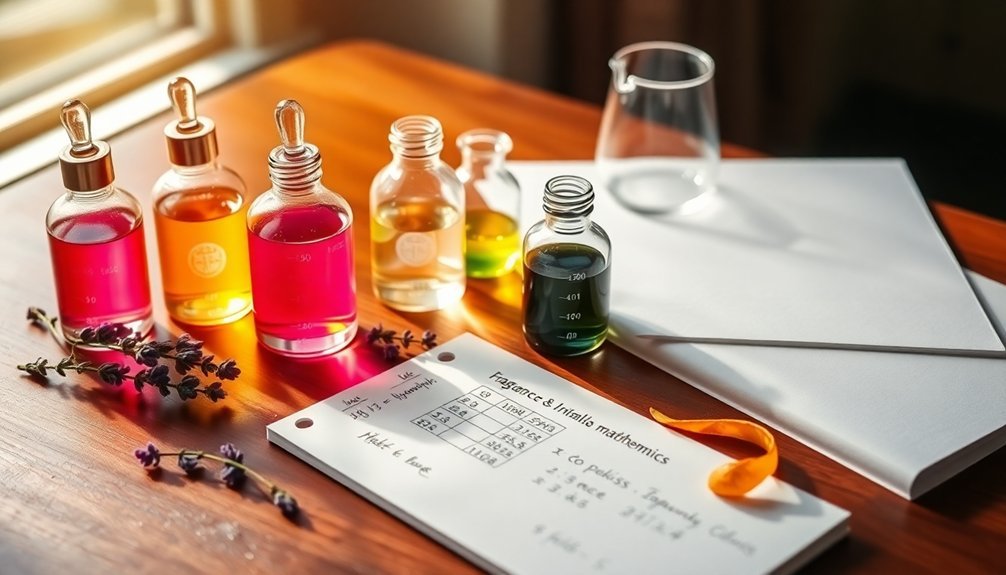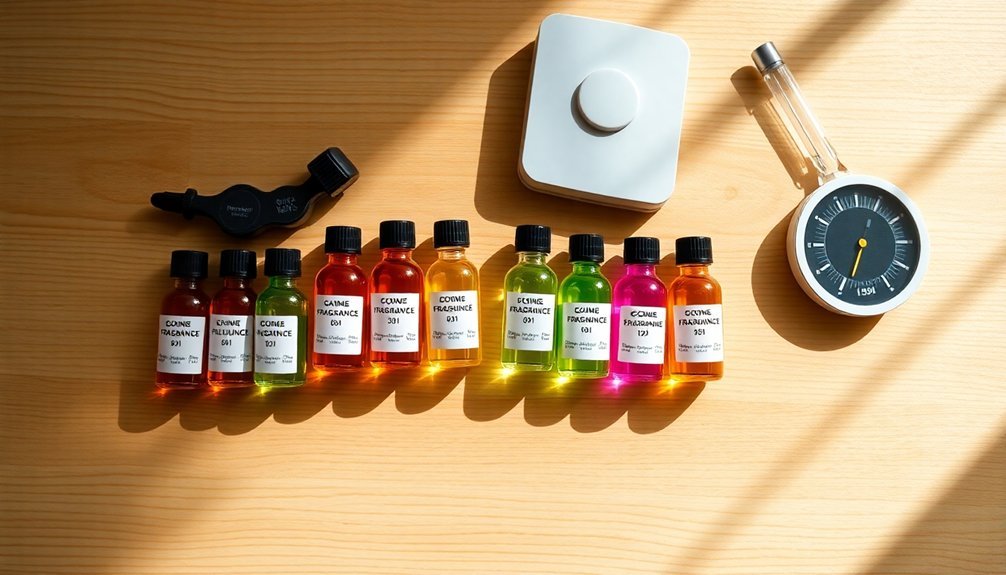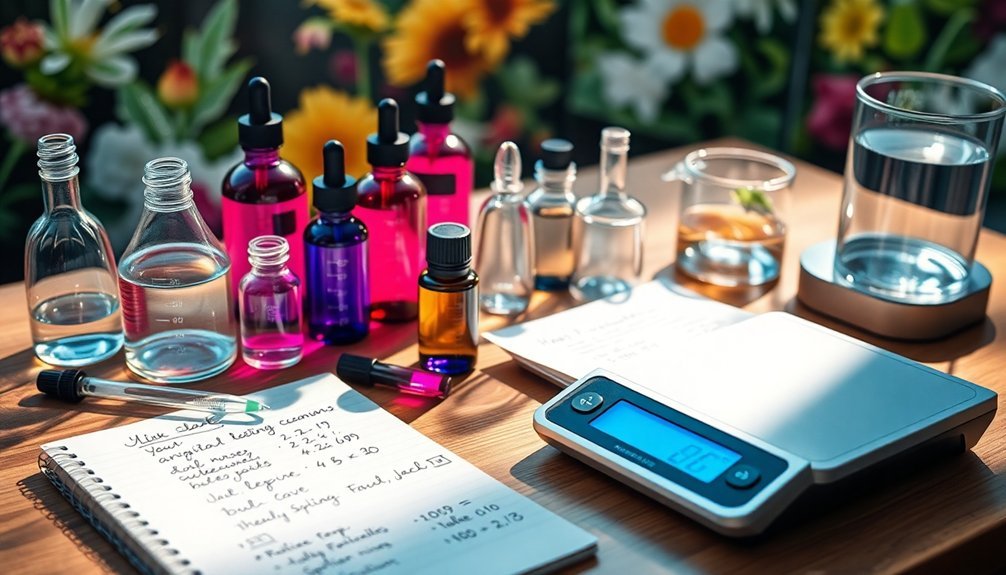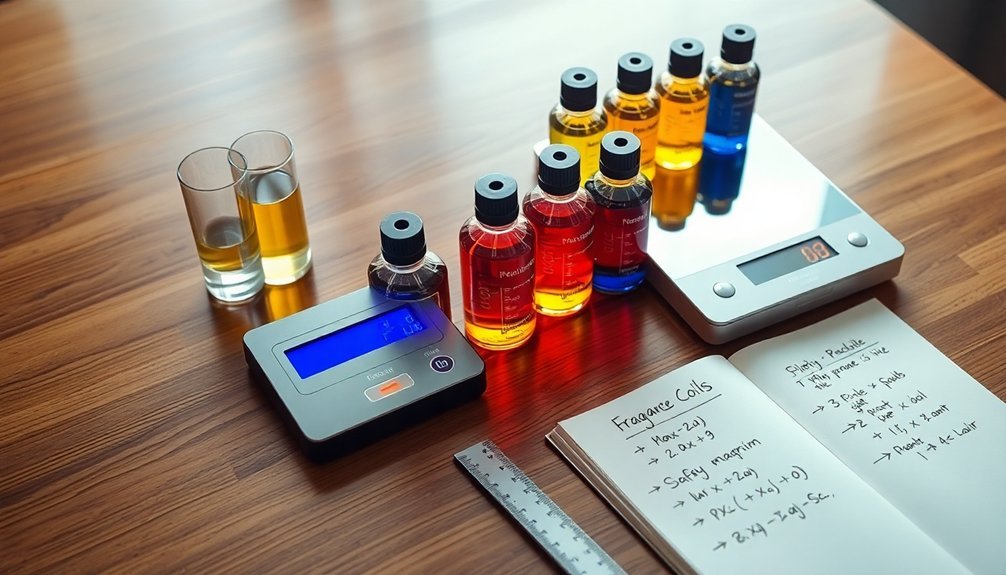To create professional fragrance oil dilutions, you'll need a digital scale for precise measurements and basic math skills. Calculate percentages by dividing ingredient weight by total solution weight, then multiply by 100. For personal care products, stick to 1-3% dilutions, while perfumes require 15-20% for EDPs and 5-15% for EDTs. Start with small test batches and document your ratios carefully. The journey from basic measurements to master perfumer involves mastering these essential fundamentals.
Understanding Basic Dilution Mathematics

When working with fragrance oils, understanding basic dilution mathematics is essential for creating accurate and safe formulations.
You'll need to master the basic concepts of concentration, which is the amount of a substance within a total solution. The key calculations involve weight percentage (wt%), parts per thousand (ppt), and parts per million (ppm). Keep a reliable digital scale nearby to ensure precise measurements of your ingredients.
To calculate the percentage of any ingredient, divide its weight by the total solution weight and multiply by 100. For example, if you're using 3 grams of fragrance oil in a 35-gram solution, you'll have 8.57% concentration.
You can easily convert between units by moving decimal points – shift right to convert wt% to ppt, and left to convert ppt to wt%.
This foundation will help you create precise dilutions for your fragrance formulations.
Essential Tools for Accurate Measurements
You'll need a digital precision scale that measures in both grams and milligrams to guarantee exact measurements of your fragrance oils.
Specialized dilution pipettes enable you to transfer small amounts of concentrated oils accurately, while graduated syringes offer another reliable method for precise volume control.
These tools work together to help you maintain consistency in your fragrance formulations and achieve the correct dilution ratios every time.
Remember that 12 drops equals approximately one-eighth teaspoon when working with your measurements.
Digital Precision Scales Required
A digital precision scale stands as the cornerstone tool for accurate fragrance oil dilutions. You'll need one that measures to at least two decimal points for creating consistent, safe formulations. Most digital scales offer multiple measurement units and can handle weights up to 2.2 pounds, perfect for both small test batches and larger projects. The scale's manual shut-off button provides convenient control during your measuring sessions.
| Feature | Benefit | Application |
|---|---|---|
| 0.01g Precision | Exact measurements | Small batch testing |
| Multiple Units | Versatile conversions | International recipes |
| Tare Function | Container weight zeroing | Accurate net weights |
| Battery Powered | Portable use | Any workspace setup |
When selecting your scale, verify it includes a stainless steel platform for easy cleaning and maintenance. You'll appreciate the user-friendly interface and compact design that won't crowd your workspace while mixing fragrance oils.
Dilution Pipettes And Syringes
Two essential tools for achieving precise fragrance oil measurements are pipettes and syringes. You'll find disposable graduated pipettes made of plastic, typically marked in milliliters, and reusable borosilicate glass syringes.
While plastic pipettes offer convenience, glass syringes provide superior chemical resistance and durability.
When measuring fragrance oils, you'll need to take into account that the standard conversion of 20 drops per mL isn't always accurate – it can vary between 37-41 drops depending on your oil and dropper. That's why using consistent measuring tools is vital.
If you choose disposable pipettes, you won't need to worry about cleaning. However, if you opt for glass syringes, you can easily disassemble and clean them after each use.
Both options work well for mixing fragrance oils with carriers, ensuring your dilutions are precise.
Common Dilution Ratios and Percentages

Understanding fragrance dilution ratios is essential for creating safe and effective scented products.
You'll find that personal care products typically require a 1-3% dilution of essential or fragrance oils, while facial products need a gentler 0.2-1.5% ratio to protect sensitive skin.
For home fragrances, you'll want to use lower concentrations: 0.5-1% for room sprays and diffusers.
If you're making candles, you'll need to increase the ratio to 5-12% of your total wax weight.
When creating perfumes, the concentration varies by type – EDPs contain 15-20% fragrance oil, while EDTs use 5-15%.
Always start with a patch test before applying any new blend, and store your diluted oils in dark glass containers to maintain their quality.
Converting Between Drops and Grams
Now that you've mastered dilution ratios, converting between drops and grams will help you measure fragrance oils with greater precision.
While many recipes use drops, professional perfumers prefer weight measurements for better accuracy.
To convert drops to grams, you'll need to understand that 1 oz equals approximately 28.35 grams or 600-650 drops.
For smaller measurements, use these quick conversions:
- 80 drops equals 1/8 oz (3.75 ml)
- 160 drops equals 1/4 oz (7.5 ml)
- 320-400 drops equals 1/2 oz (15 ml).
Remember that drop sizes can vary based on oil viscosity.
Thinner oils like citrus typically yield 40-50 drops per ml, while thicker oils like vetiver produce 30-40 drops per ml.
For the most accurate measurements, use a calibrated measuring column.
Calculating Carrier Oil Quantities

You'll need to determine the right ratio of carrier oil to fragrance oil based on your desired dilution percentage, typically starting with common ratios like 2%, 5%, or 10%.
To achieve precise measurements, always weigh your carrier oil on a digital scale rather than relying on volume measurements, as this guarantees accuracy in your final blend.
Your calculations should account for the total weight of your finished product, with the carrier oil making up the remaining percentage after you've determined your fragrance load.
Essential Ratios and Percentages
Creating the perfect fragrance oil blend starts with mastering the essential ratios between oils and carriers. You'll want to follow the 2% dilution rule for most topical applications, which means using 2 drops of essential oil per teaspoon of carrier oil.
For facial products, stick to 1% or less to protect your sensitive skin.
When you're working with specific quantities, add 5 drops of essential oil to 10ml of carrier oil for a 2% dilution. If you're making larger batches, use 1-3ml of essential oil per 100ml of carrier oil.
Remember that different applications require different ratios: perfumes can handle 1-3%, while room sprays work best at 0.5-1%.
Never exceed 5% for topical use, and always perform a patch test first.
Precision Measurement Techniques
Precise measurements form the backbone of successful fragrance oil dilutions.
You'll need a reliable calculator or perfumery app to guarantee accuracy in your measurements. When working with solid materials, use a spatula to weigh them carefully, and for liquids, rely on a pipette for exact amounts.
To calculate your carrier oil quantities, first reset your scale to zero before each measurement. For a 10% dilution, multiply your raw material's weight by 9 to determine the required alcohol amount.
Always use consistent units throughout your process, whether you're working in grams or milliliters. Keep detailed records of your measurements and calculations for future reference.
Remember to double-check your math to prevent costly mistakes in your final product.
Master Formulas for Different Applications
When crafting fragrance formulations, understanding master dilution ratios serves as the foundation for consistent and reliable results. You'll need to calculate your concentrates precisely – for a 120g fragrance at 20% strength, you'll use 24g of concentrate and 96g of ethanol.
| Application Type | Concentrate % | Ethanol % |
|---|---|---|
| Eau de Parfum | 15-20% | 80-85% |
| Eau de Toilette | 8-15% | 85-92% |
| Body Spray | 3-8% | 92-97% |
For pre-diluted materials, you'll need to work backward to determine the true amount of active ingredients. Create serial dilutions for potent materials – start with a 10% solution, then dilute further for precise control. Remember to maintain your desired ratios throughout each dilution step.
Scaling Recipes Up and Down

Successfully scaling fragrance recipes requires a systematic approach based on weight measurements and precise calculations.
You'll need to convert all ingredients, including essential oils and fragrances, from drops or volumes to weights using specific gravity measurements.
Start by determining the percentage of each ingredient in your original recipe. When scaling up or down, multiply your desired batch weight by these percentages to maintain consistent ratios.
Use a spreadsheet to organize your calculations and invest in a scale accurate to one or two decimal points.
Keep detailed records of both original and scaled recipes for future reference.
Always check your supplier's data for specific gravity information when converting essential oils.
Troubleshooting Dilution Mistakes
Making dilution mistakes can be frustrating, but they're often fixable with the right approach. When you notice your fragrance isn't quite right, whether it's too strong or too weak, you can make adjustments by carefully adding more carrier oil or fragrance oil in small increments.
Always conduct patch tests after corrections to guarantee safety and desired results.
- For over-concentrated fragrances, add carrier oil gradually until you achieve the right balance.
- For weak scents, incorporate additional fragrance oil bit by bit, testing after each addition.
- Document successful ratios to prevent future mistakes and maintain consistency.
- Test small batches first, especially when scaling up recipes.
Remember to use appropriate dilution agents for your specific product and follow standard guidelines for different applications, like 1-3% for personal care items.
Safety Margins in Calculations

Beyond fixing dilution mistakes, understanding safety margins in calculations provides an extra layer of protection when working with fragrance oils.
You'll want to stay well below maximum recommended percentages, especially when working with potentially irritating oils like clove bud or holy basil.
Build in a safety buffer by calculating your dilutions at least 0.5% lower than the maximum recommended percentage. For instance, if an oil's maximum safe dilution is 2%, aim for 1.5% in your final product.
This margin helps account for potential measurement variations and protects against skin sensitivities.
When working with phototoxic oils like lemon or grapefruit, you'll need to be even more conservative – stay at least 1% below their maximum recommended dilutions to guarantee safety.
Documentation and Record Keeping
Proper documentation serves as the cornerstone of safe and consistent fragrance oil dilution.
You'll need to maintain detailed records of every aspect of your dilution process to guarantee reproducibility and safety standards.
For professional-grade documentation of your fragrance dilutions, follow these essential steps:
- Use a scale for exact measurements and record specific weights of both essential oils and carriers, avoiding imprecise methods like counting drops.
- Create a thorough formula log that includes concentrations, dates, batch numbers, and the purpose of each dilution.
- Label all containers clearly with composition details and storage requirements, noting shelf life expectations.
- Document quality control results, including sensory evaluations and stability tests, making adjustments based on your findings and recording any changes.
These records will serve as your reference guide for future formulations and help maintain consistency in your work.
Advanced Blending Mathematics

While fragrance oil blending may seem straightforward, mastering the mathematics behind it guarantees precise, consistent, and safe formulations.
You'll need to start by converting your desired fragrance load percentage to a decimal (divide by 100). For example, a 5% load becomes 0.05.
To calculate fragrance oil weight, multiply your wax weight by the decimal fragrance load.
When you're working with multiple fragrances, divide your total fragrance load by the number of oils in your blend for equal ratios, or calculate specific proportions based on your desired blend.
Don't forget to check IFRA limits for each oil.
If you're blending a 3.42% IFRA fragrance with a 25% IFRA fragrance, you'll need to verify your final blend stays within the lower limit to maintain safety compliance.
Professional Measurement Standards
Professional measurement standards form the foundation of consistent and reliable fragrance oil formulations.
You'll need precision tools and clear conversion methods to achieve accurate results every time. When working with fragrance oils, it's essential to understand both volume and weight measurements, as you'll often need to convert between the two.
- Start by creating a benchmark – weigh a specific volume of your fragrance oil to establish a reliable conversion ratio for future batches.
- Use graduated measuring columns for precise volume measurements and electronic balances for weight accuracy.
- Follow standard dilution ratios: 1-3% for essential oils in skincare, 15-20% for perfumes.
- Always measure your dilution agents (carrier oils, alcohol, or water) with the same precision as your fragrance oils.
Frequently Asked Questions
How Long Do Properly Diluted Fragrance Oils Typically Last Before Expiring?
You'll find properly diluted fragrance oils typically last 6-12 months when stored correctly. They'll maintain their potency longer if you keep them in dark, airtight containers at room temperature, away from sunlight.
Can I Mix Different Carrier Oils Together for Custom Dilution Bases?
Yes, you can mix carrier oils to create custom bases. Combine different oils like jojoba, sweet almond, or coconut to achieve your desired properties. Just make certain they're compatible and maintain proper dilution ratios.
Does Temperature Affect the Effectiveness of Fragrance Oil Dilutions?
Yes, temperature greatly affects your fragrance oil dilutions. You'll get better blending at warmer temperatures (185°F), but don't overheat as it can degrade the oils and reduce their effectiveness.
Why Do Some Fragrances Seem Stronger Even With Identical Dilution Ratios?
Your skin chemistry, the fragrance's oil concentration, and environmental conditions all affect strength. Even with identical dilutions, you'll notice some scents smell stronger due to these personal and external factors.
Should Dilution Ratios Change Based on Seasonal Weather Conditions?
Yes, you'll need to adjust dilution ratios seasonally. Use lower concentrations in warm weather when fragrances evaporate quickly, and higher concentrations in cold weather to maintain scent projection and longevity.
In Summary
You've now mastered the essential math behind professional fragrance oil dilutions. By following these calculations, measurements, and safety guidelines, you'll create consistent, safe blends every time. Remember to keep detailed records of your formulations, double-check your math, and always stay within recommended dilution ranges. With practice, these calculations will become second nature, elevating your blending skills to professional standards.





Leave a Reply